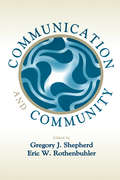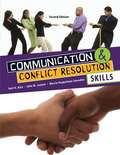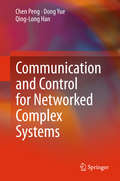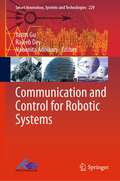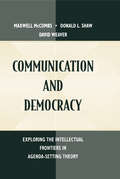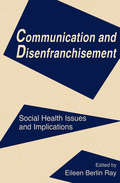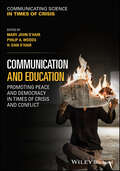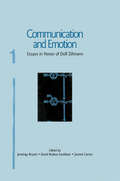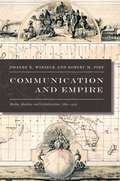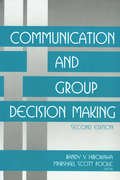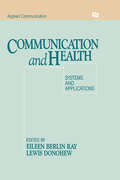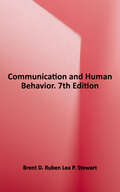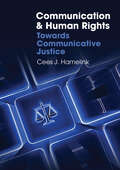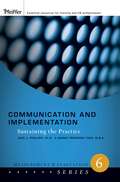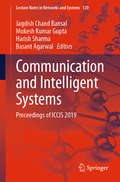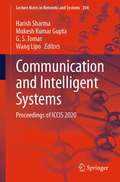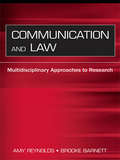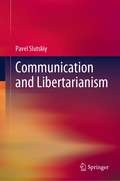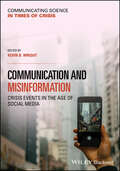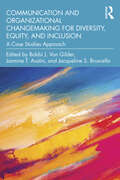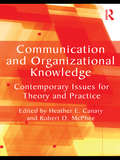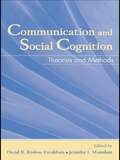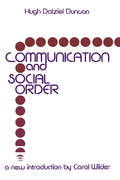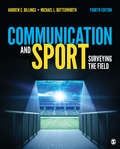- Table View
- List View
Communication and Community (Routledge Communication Series)
by Eric W. Rothenbuhler Gregory J. ShepherdThis distinctive volume combines synthetic theoretical essays and reports of original research to address the interrelations of communication and community in a wide variety of settings. Chapters address interpersonal conversation and communal relationships; journalism organizations and political reporting; media use and community participation; communication styles and alternative organizations; and computer networks and community building; among other topics. The contents offer synthetic literature reviews, philosophical essays, reports of original research, theory development, and criticism. While varying in theoretical perspective and research focus, each of the chapters also provides its own approach to the practice of communication and community. In this way, the book provides a recurrent thematic emphasis on the pragmatic consequences of theory and research for the activities of communication and living together in communities. Taken as a whole, this collection illustrates that communication and community cannot be adequately analyzed in any context without considering other contexts, other levels of analysis, and other media and modes of communication. As such, it provides important insights for scholars, students, educators, and researchers concerned with communication across the full range of contexts, media, and modes.
Communication and Conflict Resolution Skills
by Neil H. Katz John W. Lawyer Marcia SweedlerCommunication And Conflict Resolution Skills by Neil H. Katz, John W. Lawyer, and Marcia K. Sweedler
Communication and Control for Networked Complex Systems
by Chen Peng Dong Yue Qing-Long HanThis book reports on the latest advances in the study of Networked Control Systems (NCSs). It highlights novel research concepts on NCSs; the analysis and synthesis of NCSs with special attention to their networked character; self- and event-triggered communication schemes for conserving limited network resources; and communication and control co-design for improving the efficiency of NCSs. The book will be of interest to university researchers, control and network engineers, and graduate students in the control engineering, communication and network sciences interested in learning the core principles, methods, algorithms and applications of NCSs.
Communication and Control for Robotic Systems (Smart Innovation, Systems and Technologies #229)
by Rajeeb Dey Jason Gu Nabanita AdhikaryThis book is a collection of high-quality research articles. The book includes topics specific to the emerging areas of control for robotic systems, wireless communication, and development of embedded systems for robotic applications. The book integrates three important aspects of automation, namely (i) communication, (ii) control, and (iii) embedded design for robotic applications. This book is unique as it provides a unified framework for analysis, design, and deployment of the robotic applications across various engineering and non-engineering disciplines including the three primary aspects mentioned above. Furthermore, the emerging research and development work pertaining to the deployment of intelligent, nonlinear, and embedded control for robotic system for non-standard operating environment due to the widespread application of robotics technology for societal benefit is also a focal point of the book.
Communication and Democracy: Exploring the intellectual Frontiers in Agenda-setting theory (Routledge Communication Series)
by David Weaver Maxwell McCombs Donald L. ShawExciting intellectual frontiers are open for exploration as agenda-setting theory moves beyond its 25th anniversary. This volume offers an intriguing set of maps to guide this exploration over the near future. It is intended for those who are already reasonably well read in the research literature that has accumulated since the publication of McCombs and Shaw's original 1972 Public Opinion Quarterly article. This piece of literature documented the influence of the news media agenda on the public agenda in a wide variety of geographic and social settings, elaborated the characteristics of audiences and media that enhance or diminish those agenda-setting effects, and cataloged those exogenous factors explaining who sets the media's agenda. In the current volume, a provocative set of maps for explicating new levels of agenda-setting theory have been sketched by a new generation of young scholars, launching an enterprise that has significant implications for theoretical research and for the day-to-day role of mass communication in democratic societies. At the first level of agenda setting are agendas of objects--the traditional domain of agenda setting research--represented by an accumulation of hundreds of studies over the past quarter century. At the second level of agenda setting are agendas of attributes--one of the new theoretical frontiers whose aspects are discussed in detail in the opening chapters. Other chapters offer maps of yet other theoretical frontiers, including political advertising agendas and their impact on behavior, the framing of various agendas in the mass media and the differential impact of print and TV, the theoretical role of individual differences in the agenda-setting influence of the news media on the public agenda, methodological advances for determining cause and effect roles in agenda-setting, and the application of agenda-setting theory to historical analysis. This volume is an invitation to others to become active members of the invisible college of agenda-setting scholarship. As such, the goals of this book are threefold: * to introduce a broad set of ideas about agenda-setting; * to enrich the exploration of these ideas by enhancing scholarly dialogue among the members of this invisible college; and * to enhance the discussion of agenda-setting research in seminars and research groups around the world. Agenda-setting has remained a vital and productive area of communication research over a quarter century because it has continued to introduce new research questions into the marketplace of ideas and to integrate this work with other theoretical concepts and perspectives about journalism and mass communication. Understanding the dynamics of agenda- setting is central to understanding the dynamics of contemporary democracy. This book's set of theoretical essays, grounded in the accumulated literature of agenda- setting theory and in the creative insights of young scholars, will help lead the way toward that understanding.
Communication and Disenfranchisement: Social Health Issues and Implications (Routledge Communication Series)
by Eileen Berlin RayThis volume and its companion case studies book deal with some of the people, groups, and classes who are living a disenfranchised existence in the United States. Whether through birth, life events, or unfortunate circumstances, they are denied full privileges, rights, and power within the existing societal structure. Centered around societal health problems as they relate to socioeconomic status, family, abuse, and health concerns, these volumes examine salient issues from several theoretical frameworks, including feminist theory and the social construction of reality. Communication and Disenfranchisement provides theory-based essays on topics such as the homeless, adult survivors of sexual assault, battered women, persons with disabilities, impoverished women, the indigent living in the inner city, persons with HIV/AIDS, the terminally ill, and the elderly. Case Studies in Communication and Disenfranchisement provides parallel case studies, applying the issues and concepts discussed in the essays. Used together, these books provide theoretically-based applications of social health issues within a communication framework. Traditionally, health communication research has emphasized the communication-physical health relationship. Inadvertently, this primary focus has restricted what information has been included under the domain of health communication. These books expand that domain by examining how the communication-disenfranchisement relationship is accomplished, managed, and overcome, and by recognizing the significance of the pragmatic and theoretic implications of this inquiry.
Communication and Education: Promoting Peace and Democracy in Times of Crisis and Conflict (Communicating Science in Times of Crisis)
by Philip A. Woods Mary John O᾿Hair H. Dan O᾿HairA timely and insightful exploration of the vital relationships among effective communication, education, peace, and democracy Communication and Education: Promoting Peace and Democracy in Times of Crisis and Conflict explores the complexities of addressing divisive societal challenges, reducing conflicts, and building and sustaining peace and democracy around the world. Contributions by an international panel of experts provide evidence-based practices, findings from ongoing research projects, policy analyses, and cutting-edge theories, frameworks, and models for confronting global challenges to peace and democracy. Examining the crucial role of crisis communication and education on a global scale, this research-based compendium covers a broad range of key topics, such as democratizing education, promoting peace through complexity science, understanding how factionalism threatens democracy, encouraging citizen participation, and more. Throughout the text, the authors highlight the need for equity, compassion, critical thinking, and active engagement to create a sustainable future based on democratic values. Designed to enhance the knowledge base of crisis communication related to crises impacting education, peace, and democracy, Communication and Education: Explores different strategies and practices for fostering democracy in education, such as the IDEALS framework for creating positive school cultures Discusses emotional geographies in schools and their impact on democratic school climate and teacher burnout Emphasizes empathic communication and participatory skills among teachers Offers practical strategies and examples of harnessing technology for peace and democracy Provides real-world case studies illustrating the transformative power of education, music, diverse perspectives, and open communication channels Examines the ecological interdependence of effective communication, education, democracy and peace Part of the Wiley Blackwell Communicating Science in Times of Crisis series, Communication and Education: Promoting Peace and Democracy in Times of Crisis and Conflict is essential reading for communication and education scholars, researchers, students, practitioners, and community scientists.
Communication and Emotion: Essays in Honor of Dolf Zillmann (Routledge Communication Series)
by Jennings Bryant David Roskos-Ewoldsen Joanne CantorThis collection serves two important functions: it synthesizes theory and research in the vital and vibrant area of communication and emotion, and it highlights the scholarly work and contributions of Dolf Zillmann, the preeminent contributor to this area of inquiry.As one of the most productive and influential scholars in the annals of communication inquiry, Zillmann is well known for his contributions in the areas of communication, emotion, media effects, and aggression. Editors Jennings Bryant, David Roskos-Ewoldsen, and Joanne Cantor have collected groundbreaking essays from scholars active in the field, all of whom studied under or worked with Zillmann during his exemplary career. The contributions included here acknowledge the significance of Zillmann's work and identify many of the intellectual streams that contributed to his scholarship.Utilizing both psychology and communication perspectives, this volume covers the current literature in communication and emotion, with a focus on key theories, media effects, and entertainment theory. As a comprehensive synthesis of theory and research in communication and emotion, it will be of great interest to scholars in communication theory, cognitive and social psychology, and psychophysiology. With a concluding state-of-the-art chapter by Dolf Zillmann himself, this volume offers a thorough and distinctive examination of communication and emotion scholarship, and it will serve as an invaluable resource for current and future generations of scholars.
Communication and Empire: Media, Markets, and Globalization, 1860-1930
by Dwayne R. Winseck Robert M. PikeFilling in a key chapter in communications history, Dwayne R. Winseck and Robert M. Pike offer an in-depth examination of the rise of the "global media" between 1860 and 1930. They analyze the connections between the development of a global communication infrastructure, the creation of national telegraph and wireless systems, and news agencies and the content they provided. Conventional histories suggest that the growth of global communications correlated with imperial expansion: an increasing number of cables were laid as colonial powers competed for control of resources. Winseck and Pike argue that the role of the imperial contest, while significant, has been exaggerated. They emphasize how much of the global media system was in place before the high tide of imperialism in the early twentieth century, and they point to other factors that drove the proliferation of global media links, including economic booms and busts, initial steps toward multilateralism and international law, and the formation of corporate cartels. Drawing on extensive research in corporate and government archives, Winseck and Pike illuminate the actions of companies and cartels during the late nineteenth century and early twentieth, in many different parts of the globe, including Africa, Asia, and Central and South America as well as Europe and North America. The complex history they relate shows how cable companies exploited or transcended national policies in the creation of the global cable network, how private corporations and government agencies interacted, and how individual reformers fought to eliminate cartels and harmonize the regulation of world communications. In Communication and Empire, the multinational conglomerates, regulations, and the politics of imperialism and anti-imperialism as well as the cries for reform of the late nineteenth century and early twentieth emerge as the obvious forerunners of today's global media.
Communication and Group Decision Making
by Marshall Scott Poole Dr Randy Y. HirokawaDespite the importance of group communication processes, they remain elusive and difficult to understand, and the type of theory necessary to make sense of these processes differs from those commonly found in the social sciences. This collection of essays advances a unique perspective on group decision-making which is complementary to approaches taken in management, psychology and sociology. As the new edition of this book demonstrates, a number of strong theoretical frameworks have developed over the past 15 years together with considerable empirical evidence. The essays are distinctive both in their explicit focus on communication processes and in their location in a unique intellectual tradition. As such the book serves
Communication and Health: Systems and Applications (Routledge Communication Series)
by Eileen Berlin Ray Lewis DonohewThis volume examines this rapidly growing and changing field by applying a unified framework that integrates both interpersonal and mass communication investigations into theoretical and applied issues. Using a systems perspective as the organizational framework, relevant issues in the communication of health care, ranging from micro to macro levels, are discussed. The contributors recognize communication as a major factor affecting health today and therefore go beyond examinations of health communication as simply a dissemination of information regarding diseases, diagnoses, and treatments to show it as a much larger and more complex field with applications to all levels and forms of communication. Communication and Health has as its three main objecties: * providing a comprehensive, detailed, and up to-date picture of health communication * applying an integrated, logical structure to the field * making a clear, strong statement regarding the state of health communication and examining its future prospects The contributors address such issues as provider-patient communication, health care teams, health care organizations, public health campaigns, and health education, and then discuss the factors that affect the processing of health information. Also included are examinations of changes in communication use within interpersonal, small group, and organizational health care contexts as well as the use of mass media and other sources for public health campaigns and for raising public awareness of health issues on a day-to-day basis. Communication and Health fills a void in current literature on this field by serving as both a reference for professionals and researchers and as a textbook for advanced undergraduate and graduate level students in a multitude of courses.
Communication and Human Behavior
by Brent D. Ruben Lea StewartA knowledge of human behavior helps us understand ourselves, our actions, our motives, our feelings, and our aspirations… <p><p> Communication and Human Behavior portrays a broad and colorful landscape of the field, outlines the history of communication study, and focuses on communication as a basic life process that is necessary to our lives as individuals and to our relationships, groups, organizations, cultures, and societies. <p><p> Communication and Human Behavior by Brent Ruben and Lea Stewart: <p> • integrates up-to-date examples and research findings throughout, including persuasion, interpersonal relationships, organizational communication and leadership, 21st century careers, useful information about Middle Eastern culture, contemporary social media use, and more. <p> • examines the role of communication in multiple contexts of human life, including individual relationships, groups, organizations, cultural/intercultural frameworks, and public and mass communication. <p> • is expansive yet integrated, rigorous yet readable, and fuses theory and practice.
Communication and Human Rights: Towards Communicative Justice
by Cees J. HamelinkHuman rights and communication are deeply connected: human rights need communication to expose violations and to offer platforms for dialogue, while communication needs human rights to provide standards for free speech and confidentiality. Together, they confront the reality of today’s social and international order in which justice and understanding often seem unattainable.In this book, Cees J. Hamelink guides the reader through the historical evolution of communication and human rights. In this original framework, he discusses topics such as the right to communicate and freedom of expression, as well as major challenges posed by the environmental crisis and digital technologies. With authority, he passionately argues that ‘communicative justice’ is the ultimate goal of applying the international human rights regime to different forms of communication. This goal can only be achieved if we manage to move from the prevailing ‘thin’ liberal conception of human rights to a ‘thick’ cosmopolitan conception of them.Written by one of the world’s leading scholars in this area, this wide-ranging book will be of interest to students of media and communication, human rights scholars, as well as practitioners, activists and anyone interested in applying the notion of justice to the basis of human existence: communication.
Communication and Implementation: Sustaining the Practice (Measurement and Evaluation Series #6)
by Jack J. Phillips Wendi Friedman TushCommunication and Implementation is the sixth of six books in the Measurement and Evaluation Series from Pfeiffer. The proven ROI Methodology--developed by the ROI Institute--provides a practical system for evaluation planning, data collection, data analysis, and reporting. All six books in the series offer the latest tools, most current research, and practical advice for measuring ROI in a variety of settings. Communication and Implementation explores two important topics that are vital to the ROI Methodology--reporting results and sustaining the process. The authors show how to report results that will ensure that the audience has the information needed so that the improvement processes will be implemented successfully. The book explores the range of reporting methods, including face-to-face meetings, brief reports, one-page summaries, routine communication, mass-audience techniques, and electronic communications. The authors offer suggestions for determining the best methods to employ. In addition, Communication and Implementation contains information on how to keep the ROI process going for the long haul and how to make it a valued process for any organization.
Communication and Intelligent Systems: Proceedings of ICCIS 2019 (Lecture Notes in Networks and Systems #120)
by Basant Agarwal Jagdish Chand Bansal Harish Sharma Mukesh Kumar GuptaThis book gathers selected research papers presented at the International Conference on Communication and Intelligent Systems (ICCIS 2019), organised by Swami Keshvanand Institute of Technology, Management & Gramothan (SKIT), Jaipur, India and Rajasthan Technical University, Kota, India on 9–10 November 2019.This book presents a collection of state-of-the-art research work involving cutting-edge technologies for communication and intelligent systems. Over the past few years, advances in artificial intelligence and machine learning have sparked new research efforts around the globe, which explore novel ways of developing intelligent systems and smart communication technologies. The book presents single- and multi-disciplinary research on these themes in order to make the latest results available in a single, readily accessible source.
Communication and Intelligent Systems: Proceedings of ICCIS 2020 (Lecture Notes in Networks and Systems #204)
by Harish Sharma Mukesh Kumar Gupta G. S. Tomar Wang LipoThis book gathers selected research papers presented at the International Conference on Communication and Intelligent Systems (ICCIS 2020), organized jointly by Birla Institute of Applied Sciences, Uttarakhand, and Soft Computing Research Society during 26–27 December 2020. This book presents a collection of state-of-the-art research work involving cutting-edge technologies for communication and intelligent systems. Over the past few years, advances in artificial intelligence and machine learning have sparked new research efforts around the globe, which explore novel ways of developing intelligent systems and smart communication technologies. The book presents single- and multi-disciplinary research on these themes in order to make the latest results available in a single, readily accessible source.
Communication and Law: Multidisciplinary Approaches to Research (Routledge Communication Series)
by Amy Reynolds Brooke BarnettCommunication and Law brings together scholars from law and communication to talk both generally and specifically about the theoretical and methodological approaches one can use to study the First Amendment and general communication law issues. The volume is intended to help graduate students and scholars at all skill levels think about new approaches to questions about communication law by offering a survey of the multidisciplinary work that is now available. It is designed to challenge the conventional notion that traditional legal research and social science methodological approaches are mutually exclusive enterprises.This book has been developed for researchers working in mass communication and law and will be appropriate for graduate students and scholars. It will also appeal to those in psychology, political science, and other areas who are interested in exploring questions of law in their research.
Communication and Libertarianism
by Pavel Slutskiy"This is an outstanding contribution to both libertarian political philosophy and communication theory. It is far and away the most comprehensive work on communication issues in libertarian theory ever published. The author has integrated successfully the libertarian insights of Mises, Rothbard, Block, Kinsella and others with the philosophy of language as developed by Austin, Searle and Grice. He has done so in a unique and unprecedented way. The book would appeal to students and scholars interested in libertarian theory and more generally, to philosophers and political scientists interested in high-level scholarship.” - David Gordon, libertarian philosopher and intellectual historian, Ludwig von Mises Institute.
Communication and Misinformation: Crisis Events in the Age of Social Media (Communicating Science in Times of Crisis)
by Kevin B. WrightExploring the influence misinformation has on public perceptions of the risk and severity of crisis events To what extent can social media networks reduce risks to the public during times of crisis? How do theoretical frameworks help researchers understand the spread of misinformation? Which research tools can identify and track misinformation about crisis events on social media? What approaches may persuade those resistant to changing their perceptions of crisis events? Communication and Misinformation presents cutting-edge research on the development, spread, and impact of online misinformation during crisis events. Edited by a leading scholar in the field, this timely and authoritative volume brings together a team of expert contributors to explore the both the practical aspects and research implications of the public’s reliance on social media to obtain information in times of crisis. Throughout the book, detailed chapters examine the increasingly critical role of risk and health communication, underscore the importance of identifying and analyzing the dissemination and impact of misinformation, provide strategies for correcting misinformation with science-based explanations for causes of crisis events, and more. Addressing multiple contexts and perspectives, including political communication, reputational management, and social network theory, Communication and Misinformation: Crisis Events in the Age of Social Media is an essential resource for advanced undergraduate and graduate students, instructors, scholars, and public- and private-sector professionals in risk and crisis communication, strategic communication, public relations, and media studies.
Communication and Organizational Changemaking for Diversity, Equity, and Inclusion: A Case Studies Approach
by Van Gilder, Bobbi J. Jasmine T. Austin Jacqueline S. BruscellaThis book explores the opportunities, challenges, and effective approaches to organizational change regarding diversity, equity, inclusion, and belonging. Featuring application-based case studies and practical guidelines for meaningful organizational change, this book problematizes some of the current DEI initiatives in today’s organizations. It examines multiple forms of diversity (e.g., race, age, and mental health) from a variety of perspectives (e.g., leadership and employee), with case studies that demonstrate how changemaking efforts can be reimagined and implemented in better, more nuanced, and more sustainable ways to produce meaningful organizational change. Through these case studies, readers learn from organizations’ successes and failures in their attempts to implement DEI practices. Each chapter concludes with explicit practical implications and/or actionable recommendations for organizational changemaking. This text will make an impactful addition to courses in communication and diversity or organizational communication/change at the advanced undergraduate or graduate level, and will be an essential guide for professionals wishing to lead change in their organizations.
Communication and Organizational Knowledge: Contemporary Issues for Theory and Practice (Routledge Communication Series)
by Heather E. CanaryThis book provides an overview of communication-centered theory and research regarding organizational knowledge and learning. It brings the work of scholars in communication, management, information technology, and other disciplines together in a coherent volume that represents existing research and theory on communication-related knowledge work. Chapters address what constitutes knowledge, how knowledge functions within and across organizations, and how organizational members develop and manage knowledge for organizational purposes. The book also provides a forum for these scholars to pose directions for future research and theorizing. It will serve as a reference tool for scholars and practitioners to identify and understand communicative features of organizational knowledge processes.
Communication and Social Cognition: Theories and Methods (Routledge Communication Series)
by David R. Roskos-Ewoldsen Jennifer L. MonahanCommunication and Social Cognition represents the explosion of work in the field of social cognition over the past 25 years. Expanding the contribution made by Social Cognition and Communication, published in 1982, this scholarly collection updates the study of communication from a social cognitive perspective, with contributions from well-known experts and promising new scholars in diverse areas of communication. Organized into sections--message production, interpersonal communication, media, and social influence--the collection reflects the areas in which social cognition theories have become integral in understanding communicative processes, and in which a proliferation of scholarship has emerged. Readers are informed of the current major trends in social cognition research, and are introduced to its history. Throughout the text, chapter authors highlight both theoretical and methodological aspects of research, encouraging communication scholars to include social cognition in their research, and, likewise, promoting communication to social cognition researchers. The volume addresses the future of social cognition, including the most fitting directions in which to take scholarship, emerging theories in the field, and the methods currently yielding the most promising results. Communication and Social Cognition appeals to scholars, researchers, and advanced students in communication and psychology. It can be used as a textbook in graduate courses related to social cognition, social influence, message production, interpersonal communication, media effects, and message design.
Communication and Social Order
by Hugh Dalziel DuncanIn this highly influential study of art forms as models for a theory of communications, Hugh Dalziel Duncan demonstrates that without understanding of the role of symbols in society, social scientists cannot hope to develop adequate models for social analysis. He reviews critically major contributions to communication theory during the past century: Freud's analysis of dream symbolism, Simmel's concept of sociability, James' insights into religious experience, and Dewey's relating of art to experience.
Communication and Sport: Surveying the Field
by Andrew C. Billings Michael L. ButterworthCommunication and Sport: Surveying the Field provides students with an understanding of sports media, rhetoric, culture, and organizations through an examination of a wide range of topics. Authors Andrew C. Billings and Michael L. Butterworth address everything from youth to amateur to professional sports through varied lenses, including mythology, community, and identity. A comprehensive focus on communication scholarship gives attention to the ways that sports produce, maintain, or resist cultural attitudes about race, gender, sexuality, class, and politics. The Fourth Edition includes new interviews with prominent figures in the field and new discussions on current events like the Black Lives Matter movement and the COVID-19 pandemic.
Communication and Sport: Surveying the Field
by Andrew C. Billings Michael L. ButterworthCommunication and Sport: Surveying the Field provides students with an understanding of sports media, rhetoric, culture, and organizations through an examination of a wide range of topics. Authors Andrew C. Billings and Michael L. Butterworth address everything from youth to amateur to professional sports through varied lenses, including mythology, community, and identity. A comprehensive focus on communication scholarship gives attention to the ways that sports produce, maintain, or resist cultural attitudes about race, gender, sexuality, class, and politics. The Fourth Edition includes new interviews with prominent figures in the field and new discussions on current events like the Black Lives Matter movement and the COVID-19 pandemic.
